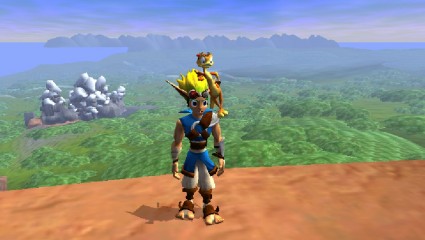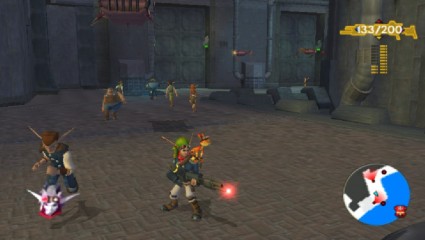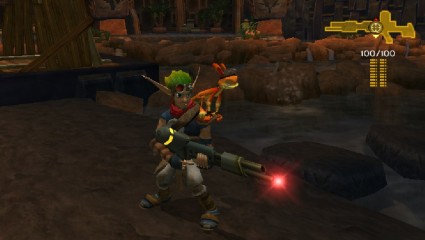Reviews
The Jak and Daxter Collection
July 18, 2013, Author: Andy Corrigan
I’ve loved the work of Naughty Dog ever since Crash Bandicoot first charmed his way onto my Playstation back in 1996, and since then I’ve loved most of their work, including this gen’s Uncharted trilogy and the seminal The Last of Us. Somehow, however, I managed to miss out on an entire golden age of PS2 platformers in-between, which obviously included the Dogs’ own insanely popular Jak and Daxter series.
With the recent re-release on Vita, I was eager to see what the fuss was about…
Jumping Jak Flash
The game that started it all, Jak and Daxter, begins with the titular duo visiting Misty Island against their village elder’s wishes. There they witness a diabolical scheme being hatched by two mystery figures and an entire army of dangerous creatures known as ‘Lurkers’. As they plot their escape, Daxter takes a tumble into a substance known as Dark Eco, which transforms him into an ‘Ottsel’. The mute Jak rushes his friend back to their home of Sandover Village, where the Elder Sage explains exactly what needs to be done to restore Daxter to his original form. The pair have a lot of work ahead of them.
In Jak II, the duo are transported to another world following the events of the first game, landing in a futuristic metropolis known as Haven City. Jak is captured and experimented on by the city’s evil overload Baron Praxis, who is currently waging war on Metal Heads; a race of vicious creatures threatening to take over the city.
Two years later, Daxter manages to free his friend and discovers that he is a changed man, now with a voice of his own and the ability to turn into a savage beast. After their daring escape, the duo hooks up with an underground rebel movement who are out to overthrow Praxis and end the war once and for all.
In Jak 3 (note that the title drops the roman numeral formatting for no reason whatsoever), Jak has been banished from Haven City by the city’s new leader, Count Veger, who deems that it was he that caused the damage and destruction from the previous game. Stranded and close to death, he is discovered by the people of nearby wasteland city Spargus, where the King allows Jak to stay in exchange for exploitation of his skills. Jak doesn’t know it yet, but he still has some unfinished business in Haven…

As you can tell…
Jak of all trades
With having to plough through three sizable games in as short a time as possible for this review, I was delighted to discover to find three very different games.
The first game, Jak and Daxter, for example, follows a template not too dissimilar to Mario 64, but adds an open-world spin on proceedings. Rather than the ‘hub-world/doorway’ system, Jak and Daxter offers access to a handful of areas at a time, all reached naturally without a single loading screen. Every action you undertake is persistent and permanent too, meaning you can half-complete tasks in one area, go off to others and explore before coming back and finishing off later. A nice little touch that would be impressive implemented now, let alone back when the game originally released.
Major story progress, however, is gated off until you’ve found the desired number of ‘Power Cells’ accumulated from each immediately available region. Finding Power Cells is the core objective in the game, and they are obtainable only by performing set tasks and challenges in each new playground. The game’s variety across this list of challenges is its single biggest strength; you’ll very rarely do the same thing twice as you jump, race, ride, attack, and defend your way to collecting those precious Cells.
Jak’s skill set is obviously paramount to your success, with Crash Bandicoot-style spins, uppercuts and punching dashes all invaluable to the cause. Every good platformer needs power-ups too, and different flavours of the substance ‘Eco’ tick that box also. Yellow Eco, for example, gives Jak fireball throwing abilities, while Blue Eco offers electrical powers and Red provides temporary invincibility. These come into play with regards to tasks and puzzles too, with the most common example of that seeing you charge Jak with Blue Eco and then using it to power switches and doors.
I have one complaint with this first game; the controls aren’t the tightest (I’d even go as far to call them finicky) and when combined with this port’s choppy framerate (something I’ll cover in further detail later), missing a platform or getting hit by an enemy can, at times, feel a little unfair. That aside, I enjoyed the experience as a series newcomer overall, finding an old-school 3D platformer whose addictive qualities outshone any negatives.
Jak II changes up the formula spectacularly, both tonally and mechanically, taking more than a few cues from Grand Theft Auto III in the process. This is evident from the very first time you jack (Jak?) a hover car and spot the familiar mini-map and mission markers at the bottom of the screen. Power Cells are a distant memory now as you perform missions for the seedy inhabitants of Haven City, with Jak looking to overthrow the totalitarian government and fight off an inhuman threat.

…Jak’s look changes…
Jak’s core platforming skill-set carries over from the previous game, although it handles a lot tighter this time around with only the rare occasion where I felt I’d died as a result of handling issues. To fit with the new vibe, Jak’s Eco power-ups have been replaced by a gun that can be upgraded four times, acting as a rifle, shotgun, machine gun and RPG all-in-one. With this, he has some new moves, such as a shooting spin attack where he fires on enemies while kicking, perfect for keeping hordes at bay in defensive missions.
Another addition to Jak’s growing list of skills is the ability to turn into Dark Jak. Collect enough Dark Eco dropped from fallen enemies and Jak can be turned into a monstrous, powerful version of himself where mêlée attacks are the only option. This is useful should you find yourself swamped with enemies, but to be perfectly honest I forgot it even existed most of the time. Dark Jak’s own list of attacks can be upgraded at a hidden Oracle statue by collecting vast numbers of the yellow orbs dropped by Metal Head enemies.
Along the way, you’ll also gain access to a hoverboard, which is a huge help for traversing some of the environments. Higher jumps and Tony Hawk-style grinds allow you to reach new areas, as well as letting you pass over dangerous surfaces unharmed.
With four buttons less on the Vita (no L2, R2, L3, or R3, of course) and many more actions than the previous game, this port looks to the back-touchpad as a replacement. At first this will feel really spotty, but there’s only a short adjustment period to get used to it and I had no major issue beyond the first hour.
Jak II’s issues come mostly in the form of inconsistent checkpointing and some abhorrently difficult missions, sometimes made all the harder thanks to crap vehicle handling and the odd frame drop.
Sometimes the game breaks its own rules too. A good two-thirds in, as an example, Jak is to race through the Haven City streets against his rival Erol (spelt Errol in the third game, oddly). The rules are clearly set in the prior cut-scene; the pair must pass through every blue ring before the finish line, and missing just one would equal instant defeat. Only countless times when neck and neck, Erol was clearly missing rings when under pressure and the race carried on, whereas the second I’d missed one it was back to the beginning.
Its absolute biggest issue, though, is the sheer amount of software crashes I experienced throughout, particularly likely following mission failures. I’d recommend saving often to avoid lost progress.
Jak 3 is similarly structured to Jak II, however it operates on a much larger scale and goes a bit Mad Max. The opening act takes place in the sandy wastelands on the outskirts of Haven City, before taking you back into a war-torn Haven later on to save the poor city for a second time.
Once again, Jak retains his abilities from both previous games, although there are some changes. This time his gun is upgradable a whopping eight times, which changes combat immeasurably. Using the rifle ammo type, for example, Jak can fire ricochet rounds or dispatch a drone that temporarily auto-fires from above. Switching to machine gun ammo, he can fire out a strong beam of electricity or homing shots, while using the shotgun he can send out chargeable shockwaves that destroy enemies in his immediate radius. It’s fun to play around with.
In addition to this, Jak earns some light powers to balance out his Dark Jak side. These are upgraded as the story allows and are activated by pressing the relevant button while Dark Jak is charging up. You could create a force field around you, heal, slow time down or even fly, all of which remain active as long as you have charge in your white Eco meter. You’ll seldom use these powers unless a particular level requires it, but they help to keep the mission-set as varied as ever.
While the game can still provide a challenge as frustrating as Jak II, Jak 3 has to be commended for better pacing and more frequent checkpoints, and the difficulty seems to spike wildly less as the game progresses in comparison. As a theme throughout the trilogy, the vehicle handling is mostly horrid, and Jak 3 is the worst offender thanks only to the sand vehicles, all of which control atrociously and violently mishandle when you approach any speed quicker than walking pace. I also had some annoying glitches when playing at Daxter in sections, as he was unable to double-jump off one type of surface for reasons unknown.
That aside, it’s probably the most rounded and better balanced of the three games included in this little compilation.
Trackie Dax
Unfortunately, framerate issues are rampant across all three games. Jak and Daxter sees the most as it’s extremely choppy from start to finish, but it’s at least consistent all the way through in spite of making the already sensitive controls feel worse. Jak II immediately seems like a huge improvement in contrast but certainly takes a nose-dive on random missions, irrelevant of size or scope.
One early mission had me crossing a bridge, and on one particular jump the framerate would slow to crawl leaving me unable to judge my landing. Suffice to say this had me dying several times over and not once was it my fault. At another point in that same level, Jak would simply disappear from my screen, leaving me unable to judge my jumps correctly. Frustrating.
In Jak 3, it does only seem to creep in with a lot of foes on-screen at one time, but the Vita has shown itself capable of much more than this. These should have been straightforward ports; instead they simply feel rushed.
There’s a lot to like in the trilogy’s design at least. Jak and Daxter is the most colourful and cutesy, while Jak II and Jak 3 bring in a lot of browns and greys to fit with their maturer themes. They don’t abandon bright colour altogether, though, keeping some splashes of bold colour for smart contrast. Jak II is also the point where Naughty Dog’s skills with facial animation start to creep into the series, making for some lovely characterisation, but it does leave Jak and Daxter feeling almost flat in comparison.

… quite a bit through the series…
Jak your body
With the three games so very different, there’s a lovely range of musical themes on offer across the trilogy. With the island-based action of Jak and Daxter, it probably shouldn’t have been a major surprise to find that its cheesy jungle melodies brought back a lot of fond Crash Bandicoot memories. Jak II on the other hand is much darker with a lot of sadness evident, while Jak 3 continues the darkly vibe but with a lot more urgency. It undeniably has the greatest impact as a result.
The voice-acting is mostly strong throughout, with wise-cracking Daxter the obvious highlight and thus the most charismatic of the cast. Jax is a mute in the first game, but acquires a voice following the experiments performed on him early into Jak II, gifting him a suitably gruff, weary heroic tone. Still it’s all made up of comical banter, with campy and enjoyable back and forth that betrays the latter two game’s darker themes.
Worth Jak?
As a newcomer to the series, I found the trilogy to be a worthwhile exercise, but only on the basis of playing though a chapter of Naughty Dog’s heritage that had previously passed me by. None of the included games have aged particularly well on this evidence, and some control and difficulty issues definitely hampered my overall enjoyment. Thanks to the rampant framerate issues and glitches too, I couldn’t escape the feeling that this package represents a rushed, sloppy port; a point made all the more obvious when, bizarrely, options for the Dualshock’s Vibration still appear in one of the games menus.
Still, series fans wanting to the play their favourite PS2 series on the go should find themselves mostly sated, but as far as I can tell, they’ll find a less-polished outing from the duo in this particular instance..
Platforms: PS Vita | Tagged Daxter, GTA, Jak, Jak & Daxter, Jak 3, Jak and Daxter, Jak II, Platformer, Precursor, Precursor Legacy, Renegade, The Last Frontier



